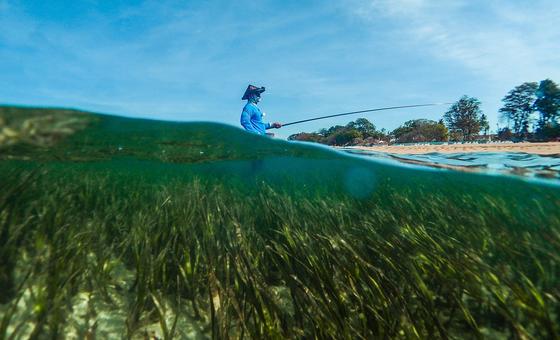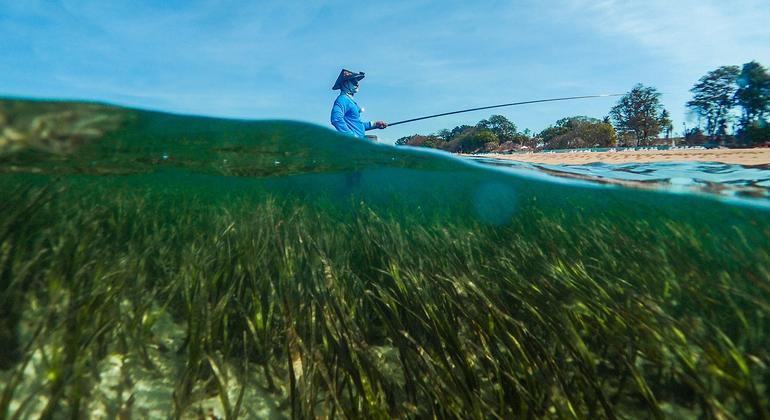
The report from the UN’s environmental wing, UNEP, also revealed that despite decades of calls for ending finance flows towards sectors that harm some of humanity’s most valuable assets, those investments currently account for a whopping 7 percent of global GDP.
Saturday’s report launch comes as negotiations on the conference’s outcome text are shifting into high gear – COP28 is scheduled to close on Tuesday – and against the backdrop of the largest on-site action yet for climate justice. Calls for ending the world’s dependence on fossil fuels and demanding reparations for ‘loss and damage‘ can be heard ringing out at Dubai’s iconic Expo City venue.
This year’s State of Finance for Nature report is the first such survey to focus on what is known as “nature-negative finance flows” and underscores the urgency to address the interconnected crises of climate change, biodiversity loss, and land degradation.
The report, launched to coincide with a day set aside at the latest UN climate conference for discussions on nature and land use, also highlighted the fact that these investments dwarfed the annual amount being invested in nature-based solutions, which totaled roughly $200 billion last year.
A staggering $5 billion of these nature-negative finance flows come from the private sector, which is 140 times larger than private investments in nature-based solutions, and almost half of that stems from only 5 industries: construction, electric utilities, real estate, oil and gas, and food and tobacco.
‘Greening finance’
One of UNEP’s partners contributing to the report is Global Canopy, a data-driven non-profit that targets market drivers that negatively impact nature. It’s Executive Director, Niki Mardas, told UN News that there is a group of companies or financial institutions who may be making nature-positive investments “and making a big noise about that, but aren’t even clear on their exposure to nature-negative [investments], particularly when it’s down their supply chains.”
He emphasized that, while these companies must continue to make positive investments, they also need to do the hard and complex work of understanding how they are driving the problem.
They must start addressing that “not by getting out and not by divesting, but by engaging companies in their portfolios, by engaging companies in their supply chains so that they change their operations and their behaviour”.
Mr. Mardas gave the example of countering deforestation, which is “at the heart” of any effort to achieve net-zero, yet only 20 per cent of the over 700 financial institutions that made high profile net-zero commitments as part of the Glasgow Financial Alliance “have taken any action at all on deforestation.”
“The single biggest action we can take for nature, climate and people is to green finance. We need to finance green, but we also need to green that $7 trillion of finance. Otherwise, we’ll always be stuck in this loop,” he added.
Turning the tide
At a press conference in Dubai, the head of UNEP’s Nature for Climate Branch, Mirey Atallah, said the report demonstrates that the climate crisis is still outpacing efforts to contain it.
She said finance is “the great enabler, and without money flowing in the right direction, we cannot achieve the targets we have set” at the 1992 Earth Summit in Rio to address the interconnected challenges of climate change, desertification and biodiversity loss.
While the report may provide very sobering conclusions, Ms. Atallah said UNEP wants to use the data to show that the money being used to harm nature can and must be diverted to have a positive impact and stressed that COP28 must be the turning point.
Speaking to UN News, the UNEP official said the chronic underfunding of nature-based solutions is not due to the lack of funds, “it’s just that the money is going in the wrong direction”.
She said convincing private companies to make the right investments requires putting in place the necessary legal frameworks to support directing funds towards nature-positive solutions.
Ms. Atallah noted that some private financial institutions have already started taking climate effects into account when approached for loans, which can help “turn the tide of investments”.
Want to know more? Check out our special events page, where you can find all our coverage of the COP28 climate conference, including stories and videos, explainers and our newsletter.



